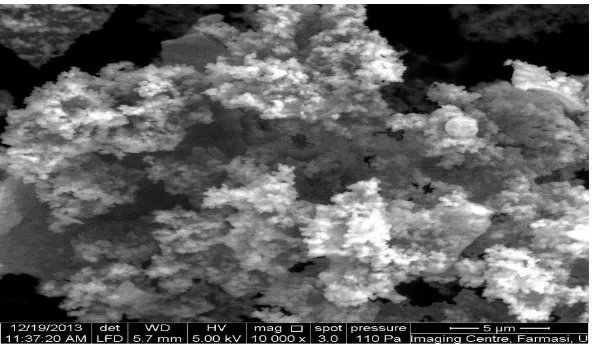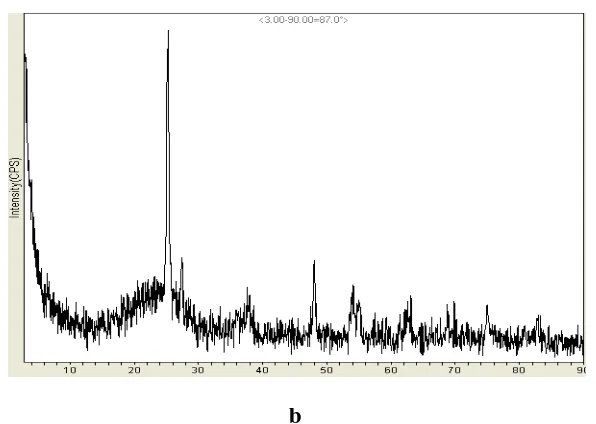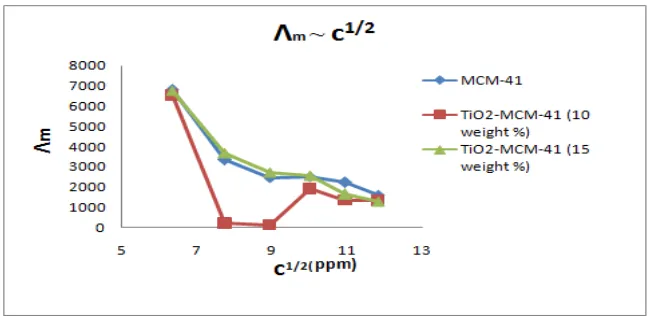CONDUCTANCE MEASUREMENTS OF MCM-41 AND TIO
2-MCM-41
IN PRESENCE OF NICOTINAMIDE (A HYDROTROPIC AGENT) IN
ETHANOL FOR PARTIALLY SOLUBLE DRUGS
Srabani Swagatika*, Suresh Kumar Dash and Upendra Nath Dash.
Department of Chemistry, I.T.E.R.,Siksha ‘O’ Anusandhan University,
Bhubaneswar-751030, Odisha, India.
ABSTRACT
The conductance measurements of MCM-41 and TiO2-MCM-41(10
and 15 weight %), have been measured in the concentration range of
40 ppm-140ppm in ethanolic solution of hydrotropic agent
nicotinamide at different temperatures ranging from 298.15 K to
313.15 K at an interval of 5 K. The conductance data have been
analyzed by Shedlovsky method to obtain Ʌ0 and KA. The
thermodynamics parameters,such as change in enthalpy, entropy and
free energy for the ion pair formation have been calculated from the
value of ion association constant at constant temperature. The results
have been discussed in terms of ion-ion, ion-solvent and
solvent-solvent interactions and also the effects of various substituents(groups)
were investigated. This investigation gave detailed information
regarding pharmakokinetics and pharmakodynamics of these drug carriers.
KEY WORDS: TiO2-MCM-41, Ethanol, Nicotinamide,Association constant.
1 INTRODUCTION
The application of mesoporous silica materials as drug carriers has shown a new hope to the
researchers for the delivery of water insoluble drugs which is the major obstacle and
challenge for most of the pharmaceutical companies[1].The modification of these materials by
certain functional groups also affects the drug delivery activity of these
materials[2].Considering this useful application of mesoporous material in medicinal field,we
have attempted to study the density and viscosity of mesoporous MCM-41[3] which provides
valuable information regarding molecular interactions taking place in the
Volume 3, Issue 7, 1079-1090. Research Article ISSN 2277 – 7105
Article Received on 22 July 2014,
Revised on16 August 2014, Accepted on 10 Sept 2014
*Correspondence for
Author
Srabani Swagatika
Department of Chemistry,
I.T.E.R.,Siksha ‘O’
Anusandhan University,
Bhubaneswar- 751030, Odisha,
system.Modification of internal pore surfaces of mesoporous materials with metal oxide
surface groups is possible.Titania nanoparticle is a low cost,low toxic,highly
stable,promising,semiconducting transition metal oxide which has proved itself very useful as
an effective catalyst, photocatalyst,electrode material,and also as an improved drug delivery
system(DDS)for cancer treatment. The titania containing MCM-41 were reported for the first
time in 1994[4].The titania incorporation into the pores of MCM-41 increases its specific
surface area(>200 m2g-1) in comparison to pure titania.So it is expected to have outstanding
applications in mesoporous form.
The limiting molar conductivity(Λm0), association constant(KA), Walden products
(Λm0η0),ΔH0, ΔS0 and ΔG0 are used as a probe for getting insight into the dynamic aspects of
ion-solvent interactions[5] .Literature reveals the study of molecular interactions of water
insoluble drugs,aminoacids,and hydrotropic agents by conductance measurements[6-8]. Many
work highlighted the effect of the solubility enhancers (hydrotropic agents)[9,10] and hence
improved solubility of the drug,but no detailed explanation is available relating to the
improvement phenomenon for a drug delivery system.Again conductometric study of
mesoporous materials in presence of hydrotropic agent is seldom reported.
The presence of silanol groups on the surface of mesororous materials facilitates the reaction
with alcohols,and the materials become stable in nonaqueous media like alcohol.Thats why
we hav attempted to study the thermodynamics behaviour,conductometric properties of solute
(MCM-41, TiO2-MCM-41) in the solvent(ethanol) in presence of a hydrotropic
agent(nicotinamide) at four different temperatures ranging from 298.15 K to 313.15 K at an
interval of 5K. The data were analyzed by Shedlovsky method[8]. The thermodynamics
parameters,such as ΔH0; ΔS0 and ΔG0for the association have been studied from the values
of ion association constant at different temperatures. The calculated values have been used to
discuss qualitatively the nature of different interactions. This study will provide better scope
for structural elucidation,delivery activity,mechanism of action and hydrotropic solubilisation
of these materials to act as potential carriers for most of the hydrophobic drugs.
2 MATERIALS AND METHODS 2.1. Materials
Cetylhexadecyltrimethylammoniumbromide(CTAB) used as structure directing agent,
Tetraethylorthosilicate(TEOS) used as the silica source, ammonia solution used as
from Merck and Degussa P-25 as titania source(80% anatase,20% rutile) ,and Sodium
hydroxide were purchased from Sigma-Aldrich.Ethanol used was of AnalaR grade and used
after dehydration with molecular sieve over night.Deionized water (Sp. Cond. ~10-6 S cm1)
was used throughtout the experiment.
2.2. Synthesis
The pristine MCM-41 was prepared as reported earlier[3].Various amounts of titania (0.30g
and 0.45g)were added to 1.5 g of CTAB in 30 ml deionized water.Then 3 ml of TEOS and
45ml of ethanol were added and stirred for 30 minutes for hydrolysis.10.1 ml of ammonia
solution was added at once to the reaction mixture causing immediate gel formation.Then the
precipitate was filtered,washed several times with deionized water and dried at 800 C for 24
h.Calcination of the samples was carried out at 5500 C for 5h.
2.3. Preparation of solution of MCM-41
The solutions of MCM-41, and TiO2-MCM-41(10 and 15 weight %), were prepared by using
0.1 M solution of nicotinamide in ethanol as solvent. The concentration of the solutions
ranges from 40ppm to 140ppm and the solutions were used on the same day.
2.4. Measurement of conductance
The conductance values of the solutions were measured by means of a conductivity meter
(Elico make) at a cell constant of 1S cm-1 at different temperatures ranging from 298.15K to
313.15K at an interval of 5K.
3 Theoretical aspects
1. The molar conductance is calculated from the specific conductance value by the relation
Λm =1000 k/c [1] Where Λm is molar conductance,k is the specific conductance and c is the
concentration of the solution.
2. Then approximate limiting molar conductance (Λm0) is obtained from the intercept of the
plot between Λm and c1/2 least squares method (10) using the equation
Λm= Λm0 –S c1/2[2] Where S is the slope and Λm0is the intercept of the plot of Λm vs. c1/2.
3. The dielectric constant of the solvent is found out by using the relation.
S=82.4/η0 (DT) 1/2 + 8.2×105/ (DT) 3/2 Λm0 (3) Where η0 and D are the coefficient of
viscosity,dielectric constant of the solvent at temperature T.
4. The experimental data of conductance measurements of the solutions were analysed using
1/ΛmS (Z) =1/Λ0 + KA/ Λ02 cΛmS (Z) (4) where S(Z) =1+Z+Z2/2+Z3/8 and Z =S(Λmc)1/2/
Λm0 3/2 From the linear plot between 1/ ΛmS (Z) and cΛmS (Z), Λm0 and KA were evaluated
from the intercept and slope, respectively.The procedure was repeated till constant values of
Λm0 and KA were obtained.
5. The free energy change, ΔG0 for the association process is calculated from the following
relation ΛG0 = - RT ln KA[5] The heat of association ΔH0 is calculated from the slope of the
plot of ln KAvs 1/T and the entropy change, ΔS0 from Gibbs - Helmholtz equation,
ΔG0
= ΔH0- TΔS0 [6]
6. The activation energy of the transport process is determined from the relation
Λm0 = A e-Es/RT or log Λm0=log A-Es/2.303RT [7]
Where A is the frequency factor, R is the gas constant and Es is the Arrhenius activation
energy. From the plot of log Λm0 vs. 1/T, the Es values have been computed from the slope
(=-Es/2.303 R)
7. The Walden product (Λm0η0) is calculated for the solutions using the coefficients of
viscosity of the solvent (η0) at temperature T.
4 RESULTS AND DISCUSSION 4.1. Characterization of materials
The Scanning Electron Microscopy (SEM) indicated the 2D hexagonal long range
mesoscopic morphology of MCM-41, and TiO2-MCM-41(10 and 15 weight %)( Figs1, 2, and
3). The uniform distribution of spherical particles representing the outer surface shows the
[image:4.595.151.448.532.707.2]typical siliceous material.
Fig 2. SEM image of mesoporous TiO2-MCM-41(10 weight %)
Fig 3. SEM image of mesoporous TiO2-MCM-41(15 weight %)
0 1 2 3 4 5 6 7
500 1000 1500 2000
In
te
ns
ity
2 (degrees)
MCM-41 (10)TiO2MCM-41 (15)TiO
2MCM-41
[image:5.595.149.447.530.701.2]X-ray diffractogram of pure MCM-41 as well as titania modified MCM-41, a diffraction peak
at 100 in low ɵ region is characteristics of long range ordered hexagonal MCM-41
mesoporous phase. This peak still remains even after modification with TiO2, which indicates
that, modification has no adverse effect on ordered mesoporous structure of MCM-41.But,
the intensities of Bragg’s peak decrease which may be due to the decrease in mesoscopic
order due to titania deposition on MCM-41(Fig 4).
FTIR investigations
Fig 5 is the FTIR image of MCM-41 and TiO2-MCM-41 (10 weight %, and 15 weight %)
between 1000-4000 cm-1 wave number. The absorption peak at 3738 cm-1 is due to the free
silanol groups.The broad band between 3100-3600 cm-1 is due to physically adsorbed
water.The peaks between 1620-1601 cm-1 are due to H-O-H stretching vibration in the
Si-O-Si structure.
Fig 5.FTIR image of mesoporous MCM-41 and TiO2-MCM-41(10 weight %, and15 weight %).
[image:6.595.148.447.348.507.2] [image:6.595.159.456.566.753.2]
[image:7.595.150.448.58.270.2]
b
Fig 6.Composite diffractogram of MCM-41(a) and 15 weight % TiO2-MCM-41
Fig 6 depicts the composite diffractogram of MCM-41 and (15 weight %) TiO2-MCM-41
which shows the XRD pattern from 0-1000 of 2θ value. The peak at 240 confirms the
hexagonal array in neat and modified MCM-41 and the peak at 25.20 and 27.30 confirms the
retention of anatase phase in TiO2.These figures are more authentic proof for retention of
hexagonal structure and rutile phase.
4.2. Conductance measurements
It is evident from Table 1 that the values of specific conductance(k),molar conductance(Λm)
and limiting conductance(Λm0) increase regularly with increase in temperature for MCM-41
and TiO2-MCM-41( 10 weight %,and15 weight%), indicating less solvation or higher
mobility of the ions in the solvent systems studied. This is due to the fact that the increased
thermal energy results in greater bond breaking and also variation in vibrational, rotational
and translational energy of molecules lead to higher frequency and higher mobility of
ions12.But it is found that,specific and molar conductance of MCM-41 are greater than that of
the titania modified TiO2-MCM-41.Between 10 weight %,and15 weight % TiO2
-MCM-41,the conductance value of latter is more than that of former except for 140 ppm at 400C.
The reason is that in the surface of MCM-41 is embedded with large number of pendant –OH
groups(8-27%) which exist as oxonium ions when dissolved in solvent.But in TiO2
-MCM-41,the silanol groups undergo co-condensation with titania forming Si-O-Ti bonds which
exist as a monolayer in the inner walls of TiO2-MCM-41(Fig 7).So conductivity decreases
with titania loading .But with increase in weight % of titania, more Ti-O-Ti bonds are
value.The limiting molar conductance of all the samples shows no regular change in
conductance value with titania loading.However, molar conductance decreases with increase
in concentration upto 80 ppm and reaches maximum at 100 ppm.Then different trend is
followed by the three samples.(Fig 8)
[image:8.595.91.498.159.333.2]Wall of MCM-41 Wall of TiO2-MCM-41 Fig 7.Mechanism for titania loading
A perusal of table 2 shows that association constant (KA) shows no regular trend with
increase in temperature.The Walden product is the highest for MCM-41which indicates weak
solvation of the ions. It is known that the variation of Walden product reflects the change of
solvation. As the weight percentage of titania increases, there is a variation trend observed in
Walden product values.From this value it is found that TiO2-MCM-41(15 weight %) is highly
solvated in the solvent.It is evident that the activation energy, Es, is positive for all the
samples in the solvent. The free energy change, ΔGo, values are positive for all the systems
studied. This shows that the dissociation process is favoured in the solvent. The positive
values of ΔHo
shows that the association process is endothermic in nature and the negative
values of ΔSo indicates that randomness is decreased in the solvent system.
[image:8.595.131.456.565.723.2]Table 1. Values of Specific conductance (k) (Scm-1), molar conductance (Scm2mol-1) and limiting molar conductance (Λm0) (Scm2mol-1) for different concentrations of MCM-41 and TiO2-MCM-41 (10 weight %, and15 weight %)in ethanolic nicotinamide solution at different temperatures.
Temp (K)
Conc.(p pm)
Specific conductance(k) Molar conductance(Λm) Limiting
molar conductance (Λm0)
298.15 M CM -41 T iO 2 -M CM -41 (10 w t. ( %) T iO 2 -M CM -41 (15 w t. ( %) M CM -41 T iO 2 -M CM -41 (10 w t. ( %) T iO 2 -M CM -41 (15 wt . ( %) M CM -41 T iO 2 -M CM -41 (10 w t. ( %) T iO 2 -M CM -41 (15 w t. ( %)
40 1.715 1.583 1.648 6784.2 6533.2 6767.9
1475.3 161.60 585.82
60 1.267 0.071 1.345 3341.3 195.32 3681.9
80 1.253 0.067 1.335 2478.2 138.22 2740.7
100 1.587 1.148 1.561 2511.1 1894.7 2564.0
120 1.681 0.976 1.200 2216.5 1342.7 1642.4
140 1.424 1.123 1.101 1609.4 1323.8 1291.6
303.15
40 2.091 1.766 1.836 8271.6 7288.4 7540.0
1475.4 784.52
569.54
60 1.517 1.201 1.573 4000.6 3303.9 4306.0
80 1.454 1.189 1.509 2875.8 2453.0 3097.9
100 1.937 1.344 1.617 3064.9 2218.1 2656.0
120 1.957 1.077 1.343 2580.5 1481.2 1838.2
140 1.627 1.255 1.227 1838.8 1479.4 1439.4
308.15
40 2.367 1.949 2.036 9363.5 8043.7 8361.3
1475.4 869.25 649.13
60 1.762 1.333 1.856 4646.7 3667.1 5080.7
80 1.651 1.310 1.643 3265.4 2702.7 3373.0
100 2.287 1.543 1.764 3618.7 2546.6 2897.5
120 2.333 1.184 1.419 3076.2 1628.3 1942.2
140 1.827 1.387 1.338 2064.9 1635.0 1569.6
313.15
40 2.643 2.132 2.243 10455 8799.0 9211.4
1475.5 930.79 698.26
60 2.009 1.486 1.937 5298.1 4088.0 5302.4
80 1.857 1.431 1.804 3672.9 2952.3 3703.5
100 2.550 1.652 1.898 4034.9 2726.5 3117.6
120 2.804 1.307 1.587 3697.3 1797.5 2172.1
Table 2. Thermodynamics parameters KA (dm3 mol-1), Λm0η0, ΔG0 (KJ mol-1), ΔH0 (J mol-1), ΔS0 (J mol-1 K-1) and Es (J mol-1)in ethanolic nicotinamide solutions at different temperatures.
Temp (K)
Param-eters MCM-41 TiO2-MCM-41(10 weight %) TiO2-MCM-41(15 weight %)
T/K 298.15 303.15 308.15 313.15 298.15 303.15 308.15 313.15 298.15 303.15 308.15 313.15
KA× 10-3 -42.56 -42.56 -42.56 -42.56 -39.22 -39.22 -39.22 -39.22 -32.39 -29.50 -30.06 -29.85
Λm0η0 14.500 13.069 11.781 10.547 1.588 6.949 6.940 6.653 5.758 5.044 5.183 4.991
ΔG0
32.13 32.67 33.21 33.75 31.93 32.47 33.00 33.53 31.46 31.75 32.32 32.83
ΔH0
0.52 2.95 3527.4660
ΔS0
-107.77 -107.77 -107.77 -107.77 -107.09 -107.09 -107.09 -107.09 -93.67 -93.04 -93.44 -93.56
5 CONCLUSION
The molar conductance of MCM-41, TiO2-MCM-41(10 and 15 weight %)has been measured
in ethanolic nicotinamide solutions at temperatures ranging from 298.15 to 313.15 K.The
conductance data have been analysed by Shedlovsky extrapolation technique.As the
temperature increases,the conductance value goes on increasing for all the three
samples.But,the conductance value of MCM-41is higher than that of the titania modified
MCM-41.It has been observed that the walden product is higher for MCM-41 than that of the
titania modified MCM-41.The ion-association constant and thermodynamics parameters have
been discussed.The values of Es are positive for all the samples in the ethanolic nicotinamide
solutions.
REFERENCE
1. Vallet-Regi M.,Ramila A.,Del Real R.P.,and Perez-Pariente J.,Chem. Mater.13,
2001;308.
2. Horcajada, P., Ramila, A., Ferey, G., Vallet-Regí, M., 2006. Influence of superficial
organic modification of MCM-41 matrices on drug delivery rate. Solid State Sci.8: 1243–
1249.
3. Swagatika S, Dash S.K., U.N.,Volumetric and Viscometric study of MCM-41 in presence
of nicotinamide(a hytrotropic agent)in ethanol,Int.J.Pharm.Sci.Rev.Res,
2014;24(1):253-258.
4. Lihitkar B.,Byaneh M.K.A,Samuel V.,Pasricha R.,Gosavi S.W.,Kulkarni S.K.,Titinia
nanoparticles synthesis in mesoporous molecular sieve MCM-41,J.Colloid Interface
Sci.314;2007:310-316.
5. Dash U. N., Roy G.S., Moharatha D. and. Talukdar M, Ion association and solvent
interaction- conductance of alkali metals and ammonium halides in aqueous binary
mixtures containing dextran at different temperatures. Physics and Chemistry of Liquids,
August 2011; 49(4):421-429.
6. Mohod S.O., The conductometric measurement of ACDTT and CTBCD at various molar
concentrations, IJMCA, 2014; Vol 4(3):141-145.
7. Pattnaik S.,and Dash U.N.,Studies on ion association and solvent interaction-conductance
of glycine in aqueous solutions of hydrotropic agents at different temperatures,Chem
8. Das S.,and Dash U.N.,Ion association of glycine,α-alanine and β-alanine in water and
water+D-glucose mixtures at different temperatures.,Journal of applied pharmaceutical
science,2013;3(9):60-64.
9. Agrawal S , Pancholi S S, Jain N K and Agrawal G P, Int J Pharm.,2004; 274:149-155.
10.Harned H.S and Owen B.B., The physical chemistry of electrolyte solution, 3rd edn,
(Reinhold, Newyork), 1958:358.
11.Shedlovsky T, MacInnes DA, Longworth LG. Limiting mobilities of some monovalent
ions and dissociation constant of acetic acid at 200C. Nature, 1932; 75:774-775.






